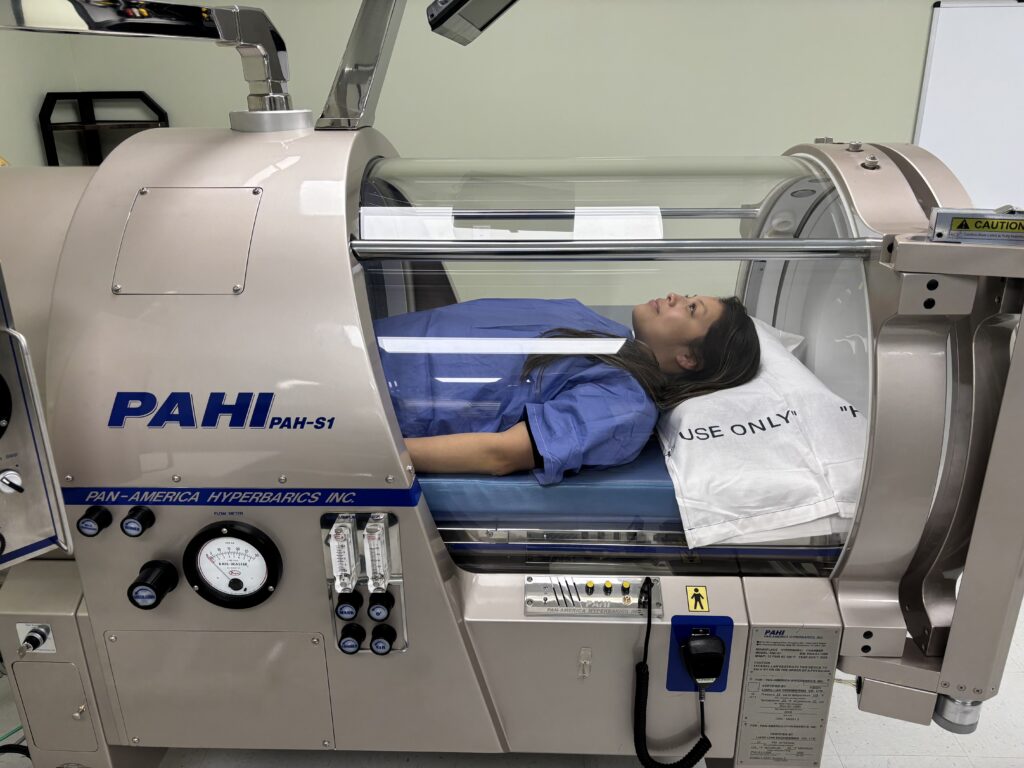FAMILY & GERIATRIC MEDICINE
ADVANCED WOUND CARE
HYPERBARIC OXYGEN THERAPY
FAMILY & GERIATRIC MEDICINE AND ADVANCED WOUND CARE CENTER
P:346-762-8822 | F:713-583-0708
HMS.ELDRIDGE@HELIUMMEDICAL.COM
146 ELDRIDGE, STE B, SUGAR LAND TX 77478
Wounds are a frequent occurrence in daily life, typically caused by minor cuts, abrasions, or surgical procedures. In most cases, these common wounds, which involve breaks in the continuity of bodily tissue, do not require specialized treatment and heal naturally with basic home remedies or simple bandages. On the other hand, non-healing wounds pose a more significant concern, necessitating a thorough medical evaluation and intervention to ensure proper healing and recovery.
Advanced wound treatments may require collaboration with specialists and the use of therapies such as Negative Pressure Wound Therapy (NPWT), Hyperbaric Oxygen Therapy (HBOT), biologics, and skin substitutes. Treatment plans are individualized to achieve the best possible outcomes.
Hyperbaric oxygen is a medical treatment in which the patient breathes pure oxygen under increased pressure. It is administered in a single person chamber and is the treatment for many medical and surgical conditions. It may be the main treatment for certain conditions but is usually part of an overall plan of care involving surgery, antibiotics or other therapy.
Hyperbaric oxygen is a simple concept. The air we breathe is normally 21% oxygen at 14.7 pounds of pressure per square inch (psi). In the chamber, the pressure can be increased to as much as 3 times normal (about 44.1 psi), and the patient breathes 100% oxygen. This increases the amount of oxygen in the blood to many times its normal levels, thereby delivering much more oxygen to all parts of the body. This increase in oxygen delivery helps improve healing and controls infection in certain conditions.
We provide Hyperbaric Oxygen Therapy (HBOT) for suitable wounds, using oxygen under pressure (2-3 times normal atmospheric pressure) to boost the body’s healing process. This therapy increases oxygen delivery to tissues and bloodstream, promoting new blood vessel growth (angiogenesis) and enhancing the body’s ability to combat infection, leading to faster and more effective healing.
The number of HBO treatments varies from 1 to 40, depending on the condition. Treatments are scheduled daily, sometimes twice a day. It’s important to be on time, as delays affect both your treatment and others.
Lower extremities diabetic ulcers
Air or gas embolism
Osteoradionecrosis
Acute traumatic peripheral ischemia
Acute peripheral arterial insufficiency
CO poisoning
Chronic refractory osteomyelitis
Central retinal artery occlusion
Crush injuries
Soft tissue radionecrosis
Compromised skin grafts and flaps
Idiopathic sudden sensorineural hearing loss
Idiopathic sudden sensorineural
Thermal burn injury
The treatment is painless, though you may feel a “fullness” in your ears at the beginning and end of your treatment, similar to changes in altitude when flying or driving in the mountains or diving underwater. This is not usually painful, but if not cleared, it could cause earache. You’ll have a water bottle to help swallow and a decongestant spray may be used before treatment. After entering the chamber, oxygen compression starts, and you may feel warm until the desired pressure is reached, which takes 10-15 minutes. The usual ear fullness will disappear, and you’ll breathe oxygen for 90 minutes. At the end, ear fullness or popping may return. Some may feel lightheaded briefly afterward. If you wear glasses for reading, you may temporarily not need them. If your eyes are normal, your reading vision may temporarily worsen. This does not hurt in anyway and is temporary. Heart rhythm and blood sugar are monitored, especially for patients with heart conditions or diabetes.
The number of HBO treatments varies from 1 to 40, depending on the condition. Treatments are scheduled daily, sometimes twice a day. It’s important to be on time, as delays affect both your treatment and others. Length and depth of dive sessions also depend on medical condition (indications).
Lower extremities diabetic ulcers
Air or gas embolism
Osteoradionecrosis
Acute traumatic peripheral ischemia
Acute peripheral arterial insufficiency
CO poisoning
Chronic refractory osteomyelitis
Central retinal artery occlusion
Crush injuries
Soft tissue radionecrosis
Compromised skin grafts and flaps
Idiopathic sudden sensorineural hearing loss
Idiopathic sudden sensorineural
Thermal burn injury

The treatment is painless, though you may feel a “fullness” in your ears at the beginning and end of your treatment, similar to changes in altitude when flying or driving in the mountains or diving underwater. This is not usually painful, but if not cleared, it could cause earache. You’ll have a water bottle to help swallow and a decongestant spray may be used before treatment. After entering the chamber, oxygen compression starts, and you may feel warm until the desired pressure is reached, which takes 10-15 minutes. The usual ear fullness will disappear, and you’ll breathe oxygen for 90 minutes. At the end, ear fullness or popping may return. Some may feel lightheaded briefly afterward. If you wear glasses for reading, you may temporarily not need them. If your eyes are normal, your reading vision may temporarily worsen. This does not hurt in anyway and is temporary. Heart rhythm and blood sugar are monitored, especially for patients with heart conditions or diabetes.
The number of HBO treatments varies from 1 to 40, depending on the condition. Treatments are scheduled daily, sometimes twice a day. It’s important to be on time, as delays affect both your treatment and others. Length and depth of dive sessions also depend on medical condition (indications).
It’s crucial to ensure your medications are compatible with hyperbaric oxygen therapy (HBO), as some drugs may interfere with treatment. Your healthcare provider will evaluate each medication, and any necessary adjustments will be discussed with your referring physician. Always keep your provider informed about your medications and any changes.